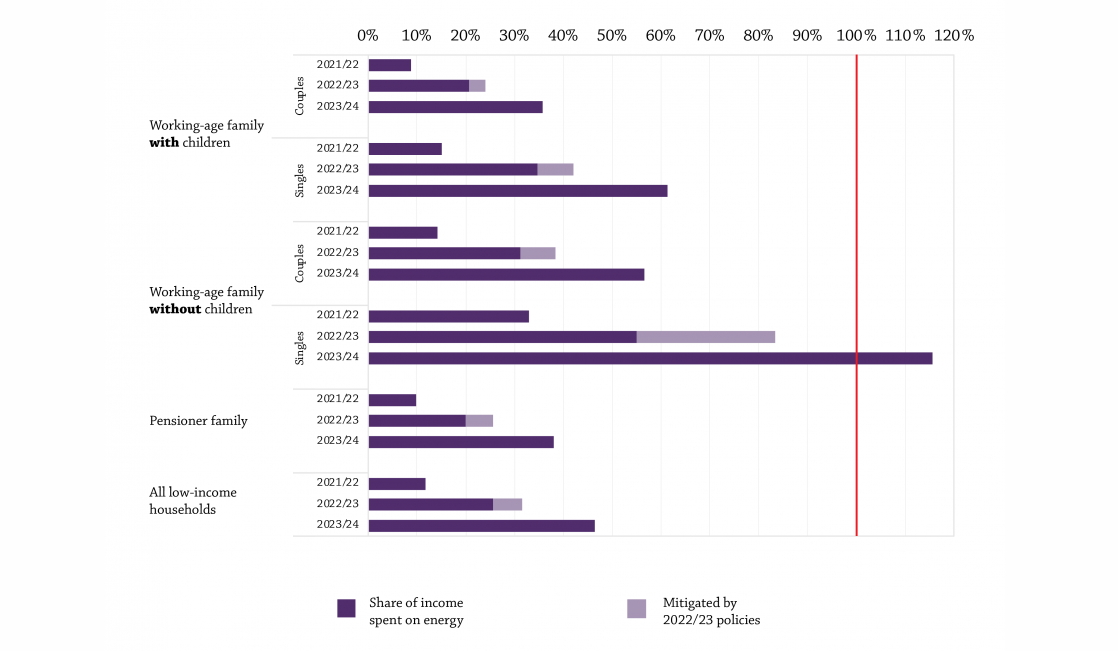Stratospheric energy bills will completely wipe out incomes for low income households
New JRF analysis of today’s Ofgem price cap and new Cornwall Insight forecasts shows energy bills will fast outstrip people’s incomes to the point where paying them becomes fantasy
- Average low-income family to pay four and a half times more for energy in 2023/24 compared to 2021/22
- Single parents will hand over almost two thirds of their income after housing costs making risk their children will go hungry very real
- Some single adults will see their finances wiped out by stratospheric energy bills that make up almost 120% of their income after housing costs, leaving many destitute
The Joseph Rowntree Foundation (JRF) is warning energy may increasingly become a luxury only the wealthy can afford, as it reveals new analysis showing low-income families will endure unthinkable bills that take a bigger bite out of their household budgets than those of the better off.
The energy regulator Ofgem announced a new price cap this morning which could see bills rise to £3,549 on average from October. Ofgem themselves say “the market for gas in Winter means that prices could get significantly worse through 2023” with Cornwall Insight forecasting further extreme price rises forecast for January and April.
In 2023/24, the poorest fifth of families, forecast to have an average income of £11,600 after taxes and paying for housing, will pay out, on average, almost half (46%) of their income on energy bills. However, middle income families, with average incomes of £31,400, will spend less than half that share – a still historically large 19% – paying the same bills.
Many households will be put in impossible situations. The energy bill for a low-income single adult household is forecast to exceed the entirety (up to 120%) of their income after housing costs. This is a truly impossible situation leaving them having to cut down on energy use even to pay their bill and having no money whatsoever left over for food or other essentials. That means in order to pay energy bills alone, they would have to use their entire income and find even more money. They would almost certainly become destitute as a result.
Couples without children and lone parents on low incomes will hand over almost two thirds of their income just to keep the lights on or cook dinner every day. For pensioners in the same financial situation, energy will make up around 40% of their disposable income.
JRF is calling for a comprehensive emergency package to kick in as soon as possible that deals with the problem as creatively and as quickly as furlough did during the early stages of the pandemic.
Peter Matejic, Chief Analyst at the Joseph Rowntree Foundation, said:
“The Government devised its support package based on a previous energy price forecast made obsolete by today’s extraordinary announcement. With the price cap very likely to increase significantly and forecast to remain high well throughout next year, our analysis shows it is a sheer fantasy to think struggling families can pay these stratospheric energy bills without further Government intervention on a significant scale.
“In all my years as an analyst, I haven’t double-checked a piece of analysis as much as this one because it is so staggering, it feels incorrect. It is impossible to think a care worker or a shop assistant will have to scramble to find hundreds more pounds to pay for their heating or that the entirety of someone’s income for a whole year will be less than their energy bill. But that’s what these figures suggest will be the case unless significant further steps are taken quickly.
“Ministers have a choice about who shoulders most of the burden – families, businesses or the public finances. Whoever occupies number 10 next will be remembered for who they protect - they must make sure energy doesn’t become a luxury only the wealthy can afford.”
“The Government must immediately respond with a comprehensive emergency package to cover the period of these extreme price rises, just as they did so creatively and quickly with furlough during the early stages of the pandemic”.

This news article is part of the cost of living topic.
Find out more about our work in this area.
